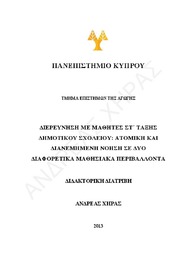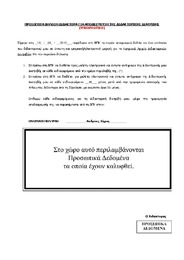| dc.contributor.advisor | Βαλανίδης, Νίκος | el |
| dc.contributor.author | Χήρας, Ανδρέας Β. | el |
| dc.coverage.spatial | Κύπρος | el |
| dc.coverage.spatial | Cyprus | en |
| dc.creator | Χήρας, Ανδρέας Β. | el |
| dc.date.accessioned | 2013-05-20T09:58:50Z | |
| dc.date.accessioned | 2017-08-03T09:39:39Z | |
| dc.date.available | 2013-05-20T09:58:50Z | |
| dc.date.available | 2017-08-03T09:39:39Z | |
| dc.date.issued | 2013-05 | |
| dc.date.submitted | 2013-05-20 | |
| dc.identifier.uri | https://gnosis.library.ucy.ac.cy/handle/7/39200 | en |
| dc.description | Περιέχει βιβλιογραφία (σ. 425-456). | el |
| dc.description | Αριθμός δεδηλωμένων πηγών στη βιβλιογραφία: 369 | el |
| dc.description | Διατριβή (Διδακτορική) -- Πανεπιστήμιο Κύπρου, Σχολή Κοινωνικών Επιστημών και Επιστημών Αγωγής, Τμήμα Επιστημών της Αγωγής, 2013. | el |
| dc.description | Η βιβλιοθήκη διαθέτει αντίτυπο της διατριβής σε έντυπη μορφή. | el |
| dc.description.abstract | Η διατριβή αποσκοπούσε να μελετήσει τον τρόπο που ένα “ενιαίο γνωστικό σύστημα” συντονίζεται και μετασχηματίζεται κατά τη διάρκεια της επιστημονικής διερεύνησης. Για το σκοπό αυτό, μαθητές Στ΄ τάξης δημοτικού σχολείου εργάστηκαν είτε σε δυάδες (διερεύνηση σε δυάδες), είτε ατομικά (ατομική διερεύνηση), επιδιώκοντας να διερευνήσουν τη λειτουργία μιας άγνωστης συσκευής. Για την επιλογή του τελικού δείγματος της έρευνας, χορηγήθηκε το δοκίμιο των “Σταθερών Μήτρων” του Raven σε 530 μαθητές της Στ΄ τάξης δημοτικού σχολείου, για τη μέτρηση της γενικής γνωστικής ικανότητάς (ΓΓΙ) τους. Με κριτήριο την ΓΓΙ, επιλέγηκε ένα μικρότερο δείγμα που αποτελείτο από 180 μαθητές. Με βάση το δείγμα αυτό, σχηματίστηκαν 60 δυάδες μαθητών τριών διαφορετικών τύπων (20 δυάδες με μαθητές υψηλής ΓΓΙ (YY), 20 δυάδες με μαθητές χαμηλής ΓΓΙ (XX) και 20 δυάδες με ένα μαθητή με υψηλή και ένα μαθητή με χαμηλή ΓΓΙ (YX)), ενώ οι υπόλοιποι 60 μαθητές (20 μαθητές με υψηλή ΓΓΙ, 20 μαθητές με μέτρια ΓΓΙ και 20 μαθητές με χαμηλή ΓΓΙ) εργάστηκαν ατομικά.
Για τη συλλογή των δεδομένων διεξήχθησαν ατομικές ή “κατά δυάδα” διερευνήσεις με τη βοήθεια μιας πειραματικής συσκευής, που αποτελείτο από 8 λαμπτήρες και 5 διακόπτες οι οποίοι ήταν συνδεδεμένοι σε “κρυμμένο” κύκλωμα στο εσωτερικό της συσκευής.
Έγινε ανάλυση των πρωτοκόλλων των ατομικών και των “κατά δυάδα” διερευνήσεων με τη Σταθερή Συγκριτική Μέθοδο ανάλυσης. Τα ποιοτικά αποτελέσματα της έρευνας έδειξαν ότι ο βαθμός συνεργασίας που αναπτύχθηκε ανάμεσα στα υποκείμενα κάθε δυάδας ήταν πολύ μικρός. Προέκυψε, ακόμη, ότι η κάθε “κατά δυάδα” διερεύνηση μπορούσε να διαχωριστεί σε τέσσερα διακριτά στάδια. Βασικό κριτήριο διαχωρισμού ήταν ο βαθμός συνεργασίας που αναπτύχθηκε ανάμεσα στα μέλη κάθε δυάδας. Επιπρόσθετα, διαπιστώθηκε ότι οι μαθητές, ανεξάρτητα αν εργάστηκαν σε δυάδες ή ατομικά, αντιμετώπισαν αρκετές δυσκολίες όσον αφορά τη δεξιότητα του ελέγχου των μεταβλητών, τη δεξιότητα συντονισμού υποθέσεων και πειραματικών δεδομένων, την ανάπτυξη της συνδυαστικής σκέψης, την αξιοποίηση των καταγραμμένων πειραματικών δεδομένων, ενώ δεν αντιλήφθηκαν τη χρησιμότητα του συστήματος εξωτερικής μνήμης.
Tα ποσοτικά αποτελέσματα της έρευνας έδειξαν ότι οι μαθητές που εργάστηκαν σε δυάδες (ΥΥ) είχαν στατιστικά καλύτερες επιδόσεις από τους μαθητές που εργάστηκαν σε δυάδες (ΥΧ) και (ΧΧ), αντίστοιχα, ενώ οι μαθητές που εργάστηκαν σε δυάδες (ΥΧ) είχαν στατιστικά καλύτερες επιδόσεις από τους μαθητές που εργάστηκαν σε δυάδες (ΧΧ). Προέκυψε ακόμη ότι οι μαθητές με υψηλή ΓΓΙ είχαν στατιστικά καλύτερες επιδόσεις από τους μαθητές με μέτρια και χαμηλή ΓΓΙ, αντίστοιχα. Επιπρόσθετα, προέκυψε ότι οι μαθητές με μέτρια ΓΓΙ είχαν στατιστικά καλύτερες επιδόσεις από τους μαθητές με χαμηλή ΓΓΙ.
Μια άλλη διαπίστωση της έρευνας ήταν ότι η μη ανάπτυξη συνεργασίας ανάμεσα στους μαθητές που εργάστηκαν σε δυάδες, είχε ως αποτέλεσμα οι επιδόσεις τους να μη διαφέρουν μεταξύ των δυάδων (ΥΥ) και των μαθητών με υψηλή ΓΓΙ που εργάστηκαν ατομικά, των δυάδων (ΥΧ) και των μαθητών με μέτρια ΓΓΙ που εργάστηκαν ατομικά και των δυάδων (ΧΧ) και των μαθητών με χαμηλή ΓΓΙ που εργάστηκαν ατομικά, αντίστοιχα.
Με βάση τα αποτελέσματα της έρευνας, αναλύονται οι εκπαιδευτικές προεκτάσεις της έρευνας και γίνονται συγκεκριμένες εισηγήσεις για το σχεδιασμό αποτελεσματικότερων ενιαίων γνωστικών συστημάτων. | el |
| dc.description.abstract | The study investigated how a "joint cognitive system" coordinated and transformed during the scientific investigation. For this purpose, sixth-grade students worked either in dyads (dyadic investigation), or individually (individual investigation), sought to explore the function of an unknown device. For the selection of the final sample of the study, Raven’s Progressive Matrices were administered to 530 sixth-grade students, as a way of measuring their general cognitive ability (GCA). Based on students’ GCA, a smaller sample of 180 students was selected. These students were assigned in 60 dyads, where 20 dyads consisted of students who had high GCA (HH), 20 other dyads consisted of students who had low GCA (LL), and the remaining 20 dyads consisted of one student having high and another student having low GCA (HL). The remaining 60 students (20 students having high GCA, 20 students having intermediate GCA and 20 students having low GCA) worked individually with the device.
Data was collected with individual or dyadic investigations conducted with an unknown device. This device consisted of eight light bulbs and five switches in another line underneath. The light bulbs and the switches were connected with a battery in a hidden circuit inside the box, in a way that only one or none of the lamps could light on.
The interview data was transcribed and analyzed using the Constant Comparative analysis method. The qualitative analysis of the data indicated that the degree of collaboration in each dyad was very small. Based on the degree of collaboration, each dyadic investigation could be divided in four discrete stages. Additionally, the results showed that students, working either in pairs or individually, faced several difficulties in terms of the control-of-variables strategy, the development of combinatorial reasoning, the ability to co-ordinate their hypotheses with the collected evidence, and they did not take full advantage of their recorded data, since, in many cases, they did not realize the usefulness of using an external memory system.
The results of the quantitative analyses indicated that students assigned to HH dyads significally outperformed students assigned to the LH and the LL dyads, and students assigned to the HL dyads significantly outperformed students assigned to the LL dyads. The results also revealed that students with high GCA performed significantly better than the students with intermediate and low GCA, and students with intermediate GCA performed significantly better than students with low GCA, respectively.
The lack of collaboration between students working in dyads justifies why the "Investigation37T Ability37T" did not significantly differ between HH dyads and students with high GCA who worked individually, or between HL dyads and students with intermediate GCA who worked individually and LL dyads and students with low GCA who also worked individually, respectively.
Educational implications of the results of the study are clearly discussed and concrete suggestions for assigning students to groups and the design of optimal joint cognitive systems are also provided. | en |
| dc.format.extent | xxv, 456 σ. : εικ. (ορισμένες έγχρ.) ; 30 εκ. | el |
| dc.language.iso | gre | en |
| dc.publisher | Πανεπιστήμιο Κύπρου, Σχολή Κοινωνικών Επιστημών και Επιστημών Αγωγής / University of Cyprus, Faculty of Social Sciences and Education | |
| dc.rights | info:eu-repo/semantics/openAccess | en |
| dc.rights | Open Access | en |
| dc.subject.lcsh | Team learning approach in education Cyprus | en |
| dc.subject.lcsh | Memory in children | en |
| dc.subject.lcsh | Child development Cyprus | en |
| dc.subject.lcsh | Cooperativeness in children | en |
| dc.subject.lcsh | Learning, Psychology of | en |
| dc.subject.lcsh | Group work in education Case studies | en |
| dc.title | Διερεύνηση με μαθητές ΣΤ' τάξης δημοτικού σχολείου : ατομική και διανεμημένη νόηση σε δύο διαφορετικά μαθησιακά περιβάλλοντα | el |
| dc.title.alternative | Sixth-grade Students’ Investigation: Individual and Distributed Cognition in Two Different Learning Contents | en |
| dc.type | info:eu-repo/semantics/doctoralThesis | en |
| dc.contributor.committeemember | Χρίστου, Κωνσταντίνος | el |
| dc.contributor.committeemember | Αγγελή-Βαλανίδη, Χαρούλα | el |
| dc.contributor.committeemember | Μαρκουλής, Διομήδης | el |
| dc.contributor.committeemember | Γωνίδα, Σοφία-Ελευθερία | el |
| dc.contributor.committeemember | Βαλανίδης, Νίκος | el |
| dc.contributor.committeemember | Christou, Constantinos | en |
| dc.contributor.committeemember | Angeli-Valanide, Charoula | en |
| dc.contributor.committeemember | Markoulis, Diomides | en |
| dc.contributor.committeemember | Gonida, Sofia-Eleutheria | en |
| dc.contributor.committeemember | Valanides, Nicos | en |
| dc.contributor.department | Πανεπιστήμιο Κύπρου, Σχολή Κοινωνικών Επιστημών και Επιστημών Αγωγής, Τμήμα Επιστημών της Αγωγής | el |
| dc.contributor.department | University of Cyprus, Faculty of Social Sciences and Education, Department of Education | en |
| dc.subject.uncontrolledterm | ΔΙΑΝΕΜΗΜΕΝΗ ΝΟΗΣΗ | el |
| dc.subject.uncontrolledterm | ΕΝΙΑΙΟ ΓΝΩΣΤΙΚΟ ΣΥΣΤΗΜΑ | el |
| dc.subject.uncontrolledterm | ΕΠΙΣΤΗΜΟΝΙΚΗ ΔΙΕΡΕΥΝΗΣΗ | el |
| dc.subject.uncontrolledterm | ΕΠΙΣΤΗΜΟΝΙΚΟΣ ΣΥΛΛΟΓΙΣΜΟΣ | el |
| dc.subject.uncontrolledterm | ΣΥΣΤΗΜΑ ΕΞΩΤΕΡΙΚΗΣ ΜΝΗΜΗΣ | el |
| dc.subject.uncontrolledterm | ΓΝΩΣΤΙΚΗ ΙΚΑΝΟΤΗΤΑ | el |
| dc.subject.uncontrolledterm | DISTRIBUTED COGNITION | en |
| dc.subject.uncontrolledterm | JOINT COGNITIVE SYSTEM | en |
| dc.subject.uncontrolledterm | SCIENTIFIC INVESTIGATION | en |
| dc.subject.uncontrolledterm | SCIENTIFIC REASONING | en |
| dc.subject.uncontrolledterm | EXTERNAL MEMORY SYSTEM | en |
| dc.subject.uncontrolledterm | COGNITIVE ABILITY | en |
| dc.identifier.lc | LB1032.H47 2013 | en |
| dc.author.faculty | Σχολή Κοινωνικών Επιστημών και Επιστημών Αγωγής / Faculty of Social Sciences and Education | |
| dc.author.department | Τμήμα Επιστημών της Αγωγής / Department of Education | |
| dc.type.uhtype | Doctoral Thesis | en |
| dc.rights.embargodate | 2016-05-10 | |


